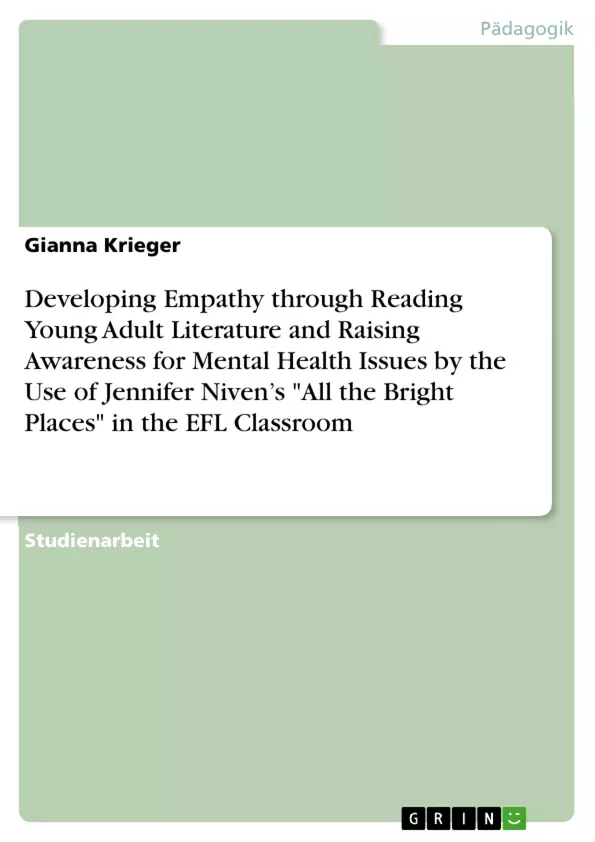How does reading Young Adult Literature contribute to the development of empathy, and how can this process be addressed and fostered in the classroom - using the example of All the Bright Places by Jennifer Niven? To answer this question, I will first outline how readers develop empathy in the process of reading Young Adult Literature, in order to illustrate this in the following chapter using All the Bright Places by Jennifer Niven as an example. These findings will also be related to foreign language teaching: goals as well as teaching ideas will be suggested on how All the Bright Places can be used in the classroom to support the empathy development of adolescents.
Have you ever cried while reading, could you ever not help smiling, or even laughed out loud? Have you ever felt so involved in a story that you could not think about anything else, and your emotional life was dependent from the emotional life of the protagonists? In these moments, the reader's emotional life is significantly influenced by the story in his/her hands.
All the Bright Places by Jennifer Niven is a story comparable to Shakespeare’s Romeo and Juliet. Two members of completely different social groups, who are unhappy with their lives, surprisingly fall in love and try to safe each other – but cannot. Since the two protagonists, Finch and Violet, suffer from different mental illnesses and traumas, All the Bright Places also addresses a topic that still receives too little empathy in our society.
In teacher trainings, you gain an understanding of some of the skills that are developed through reading literature. Accordingly, one of the things people learn through reading literary texts is to adopt the perspectives of others because in the flow of reading one is repeatedly confronted with the opinions, feelings, and thoughts of other (fictional) individuals. If reading fictional literature promotes the ability to understand the perspectives of others, does it not by inference also promote the ability to empathise? Is reading fictional texts a component of the development of empathy? And how big, how significant, is this component?
Inhaltsverzeichnis
- Introduction
- Developing Empathy through Reading Fiction
- Definition of Empathy
- Developing Empathy through Reading Fiction
- Factors
- Narrative Empathy through Reading All the Bright Places
- All the Bright Places by Jennifer Niven in the EFL Classroom
- Goals of Teaching All the Bright Places
- Teaching Ideas
- Conclusion
Zielsetzung und Themenschwerpunkte
Die vorliegende Arbeit untersucht, wie das Lesen von Young Adult Literatur zur Entwicklung von Empathie beitragen kann, insbesondere am Beispiel von Jennifer Nivens Roman "All the Bright Places". Sie befasst sich mit der Frage, welche Faktoren die Empathieentwicklung beim Lesen von fiktionalen Texten fördern und wie diese Prozesse im Fremdsprachenunterricht genutzt werden können.
- Definition und Bedeutung von Empathie im Kontext des Lesens
- Empathieentwicklung durch das Lesen von fiktionalen Texten
- Analyse der Empathie-fördernden Elemente in "All the Bright Places"
- Einsatz des Romans im Fremdsprachenunterricht zur Förderung der Empathie
- Didaktische Ansätze und konkrete Unterrichtsmaterialien
Zusammenfassung der Kapitel
- Introduction: Die Einleitung stellt das Thema der Arbeit vor und erläutert den Zusammenhang zwischen dem Lesen von fiktionalen Texten und der Empathieentwicklung. Sie führt den Roman "All the Bright Places" von Jennifer Niven ein und hebt dessen Relevanz für die Förderung von Empathie und Sensibilisierung für psychische Gesundheit hervor.
- Developing Empathy through Reading Fiction: Dieses Kapitel befasst sich mit der Definition von Empathie und erläutert, wie Empathie beim Lesen von fiktionalen Texten entwickelt werden kann. Es werden verschiedene Theorien und Studien zur Empathieentwicklung im Kontext des Lesens beleuchtet und die Rolle von Perspektivübernahme, Identifikation und emotionaler Beteiligung diskutiert.
- Narrative Empathy through Reading All the Bright Places: In diesem Kapitel wird untersucht, wie der Roman "All the Bright Places" Empathie beim Leser erzeugt. Es werden die Charaktere, Handlungselemente und Themen des Romans analysiert und deren Einfluss auf die Empathieentwicklung des Lesers untersucht.
- All the Bright Places by Jennifer Niven in the EFL Classroom: Dieses Kapitel präsentiert Ideen und Ansätze für den Einsatz des Romans im Englischunterricht. Es werden didaktische Ziele, Unterrichtsmaterialien und methodische Vorgehensweisen beschrieben, die dazu beitragen können, dass Schüler durch das Lesen des Romans Empathie entwickeln und ihre Sprachkenntnisse verbessern.
Schlüsselwörter
Empathie, Young Adult Literatur, "All the Bright Places", Jennifer Niven, Perspektivübernahme, Identifikation, emotionale Beteiligung, Fremdsprachenunterricht, didaktische Ansätze, Unterrichtsmaterialien, mentale Gesundheit
- Quote paper
- Gianna Krieger (Author), 2021, Developing Empathy through Reading Young Adult Literature and Raising Awareness for Mental Health Issues by the Use of Jennifer Niven’s "All the Bright Places" in the EFL Classroom, Munich, GRIN Verlag, https://www.grin.com/document/1170332



